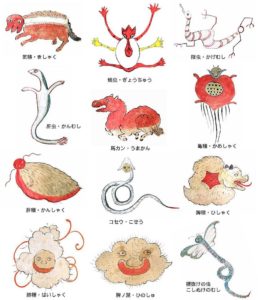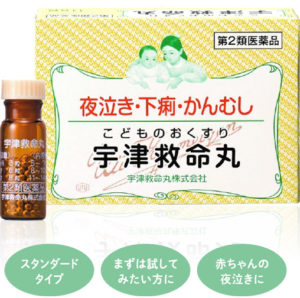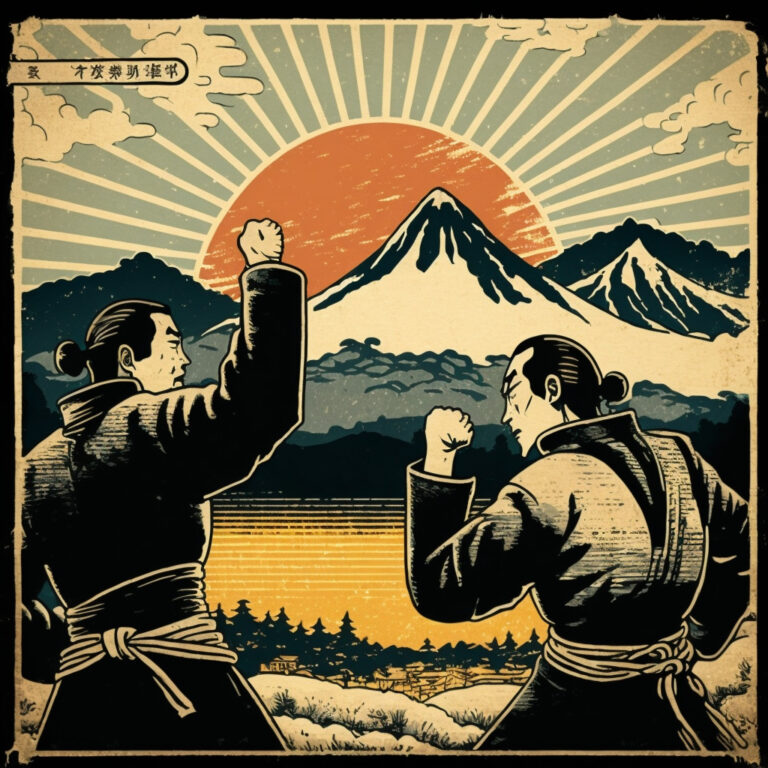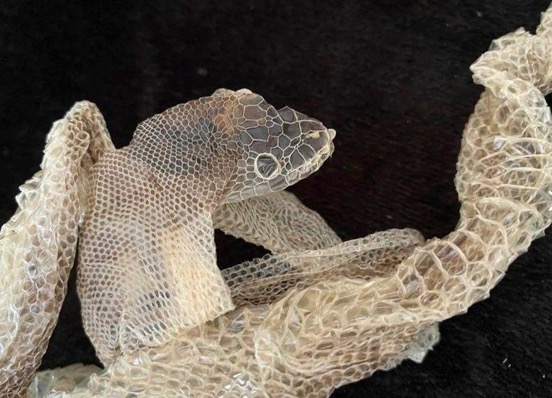Today let me tell you why your toddler might cry at night and throw tantrums and what you can do to remedy. It could be a mythical kan-no-mushi parasite that lives in their spine. And you might have them, too.


There are different methods to remove these strange bugs. One is that you can perform certain rituals that involve chanting, salt, and/or calligraphy ink. Another way is by taking this over the counter medicine, an over four hundred year recipe.
I’m so excited about today’s episode. It’s weird and obscure and something I’ve been wanting to share with the world since I first learned about it 24 or 5 years ago.
The setup: My son Julyan was a baby and he was quite the light sleeper. The kind of kid that if you were rocking him and he fell asleep you thought twice about putting him down on his futon, because chances were he’d wake right back up. I don’t remember it being too big of a deal for me, but for some reason or other that really stood out to my mother-in-law.
Cue the day she told me: His Kan no mushi ga tsuyoi. Which I had no idea what she was talking about. I understood mushi which usually meant bug and tsuyoi was strong. Kan no mushi ga tsuyoi.
Again, this was pre-Internet, so I just had her explanation and my meager understanding of Japanese to try to piece this puzzle together. What I gathered was that there was some kind of worm that lived inside my son that wouldn’t allow him to sleep soundly.
She explained that children who cry a lot, especially at night, who can’t calm down, or who throw tantrums, all have this kan no mushi thing. She kept rubbing circles on the palm of her hand and said the worm needed to come out. She even bought me some strange medicine she wanted me to give him, but when I asked what it was she couldn’t really explain, or maybe I couldn’t really understand.
I’m sure you can imagine my utter horror and confusion, a worm lived inside my kid? Well, this dismay lasted many years. But now thanks to the invention of the Internet and my Japanese having gotten much better, I know what she was talking about.
And today I’m going to tell you everything I’ve learned and heard so you, too, can have your mind blown by these dorky-looking parasites that are living in your children and wreaking havoc on their bodies.
Hey hey,
How are ya’ll doing today? Very well, I hope. I want to start by thanking everyone who listened to, subscribed to, and even reviewed the new Soothing Stories podcast. I’ve been so nervous about it, but you have helped calm my anxious mind with your kindness and have got me excited about all future stories.
The newest episode should be up or should be going up soon. It’ll be Charlotte Perkins Gilman’s “The Yellow Wallpaper”. Another sweet horror piece to put you to sleep. And don’t think the irony of our new podcast’s name and the stories I’m drawn to is lost on me. I kind of find it hilarious.
What is Kan-no-mushi?
Now back to microscopic bugs. I’ve seen kan no mushi (疳の虫) also called kan mushi translated as “a disease causing bug”. That sounds about right. But let’s look at the kanji. Mushi, we know is bug or insect. Kan (疳), however, is a character that refers to (and I’m quoting here): a type of pediatric illness characterized by malnutrition due to digestive problems or parasites. That character, kan, is the one used these days. It used to be different.
The Harikikigaki (針聞書)
Let’s go back in time almost five hundred years and look at a medical text called the Harikikigaki (針聞き書き). Which is the funnest word to say. Anyway, here you won’t only find various diseases and how to cure them with acupuncture and herbal medicine, you’ll also find (I’m convinced) where all those wacky Ultraman and Kamen Rider villains came from. I’d venture to guess that nowhere is there a more adorable medical document explaining the horrors of parasites.
Now of all the different disease-causing bugs from the Harikikigaki, most have been forgotten over time. All except one. The kan no mushi. But one big change I noticed is the character for kan (肝). Back then they used the kanji for liver. So liver bug!
What Does it Do?
A kan no mushi is a tiny wormy thing that takes up residence inside a person’s spine. Back in the day it might have affected anyone, but more recently when you talk about kan no mushi, it is specifically about children. It’s kind of a catch all for what is wrong with your child. They’re not hungry or wet or too hot or cold, and yet, they’re being fussy, or moody, hyperactive, have mysterious stomach aches, cry all night, or throw random tantrums. You name it, the kan no mushi just might be the culprit.
But you can’t treat a baby or child with acupuncture. It’s too harsh for their little bodies, so there were other ways to drive out this offending, albeit kawaii, bug. I’ll get to that in a minute.
How Common is Kan no Mushi Belief?
But first, I’m not saying every Japanese person you meet will know about this phenomena, they won’t. The younger the person you’re talking to is, the less likely they’ll have heard of it. However, remember last week we talked about koushin shinko the ritual held every sixty days? Well, kan mushi is quite a bit more well known than that. I’ve been randomly asking friends about it and most of them have heard of it or were told they had it as a child, they’re just fuzzy on the details.
How to Cure it
Let me backup twenty something years again to my mother-in-law trying to teach me about this diagnosis she made and how to cure it. As I understood it at the the time she was saying there was a ritual to draw out the thin worm. If we did that, then, no more random crying and his baby balance would be restored. The ritual involved visiting someone skilled in this, paying some money, and then something about using a brush and ink and chants to get the bug to come out. Needless to say, I wasn’t up for it. She did end up buying some medicine she said would also help. More on that in a second.
I know now that there are different types of rituals used to expel these dastardly bugs. Because, yes, you can have more than one inside you at a time. And since you can’t use acupuncture there are some non invasive tools that are just rubbed over the skin in some certain way with chanting. I’ve also seen someone use salt that is rubbed and held in the hands to remove the bugs.
But I was most surprised to find a technique that sounds exactly like what my mother-in-law told me. Here the person performing the ritual takes an ink stick and grinds some thin ink, then with a calligraphy brush, they paint a small, coin-sized dot on the toddler’s or baby’s palm, continuing to make circle with the brush while reciting a Buddhist sutra, or okyo. The person I read who did this one, said any sutra will do.
Now this goes on, circling, circling, chanting chanting, and after a little while you will see these very fine thread like things come out of the hand, usually around the fingers. I’ve only seen this on Youtube and it’s weird. Really weird. But the story goes that once these hair-like parasites have fled the child’s body, they’ll return to being a sweet kid again.
Symptoms
So other than the fits of crying, tantrums, and fussiness, what are some of the things that might signify your child has a strong kan no mushi? Well, I found a list:
The child could have a pale complexion, blue streaks or fret lines between the eyebrows, the whites of the eyes have a bluish tint, the bottom of the nose could turn red, the area around their lips is yellowish or blackish, the area around their belly button is sore, and my favorite, their hair could be standing up on end.
Over the Counter Medicine
If you don’t have anyone around who can do the ritual, you can always get the medicine. One that is quite popular is called Uzukyumeigan (宇津救命丸) which I learned from their website has been around for more than four hundred years.
I always wondered what was in the little vial my mother-in-law gave me. It looked cool, a tiny bottle, half the size of your pinky finger, filled with these really, really tiny, shiny beads. I was supposed to give him one a day. Instead, I ate a couple and they were bitter. But that’s all I remember. To this day they still sell over counter medicines for kan no mushi, so I decided to see if I could find out what was in those incredibly tiny pills. The Uzukyumeigan website was very kind and gave a listing and description of all the herbs, spices, and eyebrow raising ingredients. So here we go.
There’s ginseng, musk, ouren (オウレン) which is an wild grass called Japanese goldthread, and kanzou (甘草). The characters for this are sweet grass. It’s a herb from the licorice family. I’ve had this quite a bit throughout the years. It’s said to help relieve sore throats and stomach pain. Okay, so we’re fine up to there. Then comes:
Gou (牛黄) or a bezoar. Now let me tell you what a bezoar is because I had no idea. This is going to get weird. Bezoar is a Persian words that means antidote, and was thought to be a universal antidote against all poisons. But what is it?
First, you take a ruminating animal, in this case a cow, and that cow eats hair. I told you it was going to get weird. And that hair stays in its stomach for years until it becomes this hardened round mass. Then after the cow has died, you examine its stomach contents and retrieve the bezoar. It looks like this was considered quite magical in many cultures back in the day.
Next, yuutan (熊胆). The characters are easy and distressing. Bear gallbladder. So. There.
And last, you have reiyoukaku (羚羊角) which is the dried antler of these two types of antelopes that live in Northern China and Mongolia. But they’re kind of going extinct and regulated by the Washington Convention. So.
Conclusion
So that’s what it is, if your little one is fussy and you cannot for the life of you figure out why, he or she might have kan no mushi.
Now, I’m going to leave you with a tiny warning. You can, if you’d like, do an image search for kan no mushi. It works in English, too. And you might see the incredibly cute drawings from the Harikikigaki. You’ll also see photos of little hands with these freaky thread like things coming out. Yes, I’m getting a little queasy, too. And if you’re particularly unlucky, remember this is also considered a parasite, some other something might pop up. Anyway, I’m going to put the cut images up on the Uncanny Japan website, along with all the kanji characters, so consider that your safe search.
So that’s all for today. But before I go, I wanted to mention that Richard and I are going to try something new and interesting. Since starting the Soothing Stories podcast and all my writing projects, and him working on the Japan Distilled as well as everything he’s got going on, we’re going to start tracking our time spent on our various ventures. From researching to writing, recording, editing, doing the sound, music, final edits, blog post, and getting it all tied up with a bow and into your ears. So if you’re as curious as I am…we’ll be
Anyway, thank you so much for listening and for your support, by listening, subscribing, reviewing, or supporting view Patreon.
I’m going to go downstairs now and finish writing the this fun folklore piece I found about Mount Fuji for this month’s bedtime story over on Patrons and then start working on the next soothing story I want to read.
Please stay safe and well and out of incremental weather. I’ll talk to you in two weeks,
Bye bye!
Credits
Intro and outro music by Julyan Ray Matsuura.






